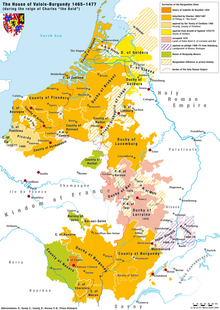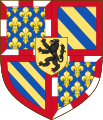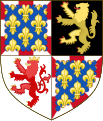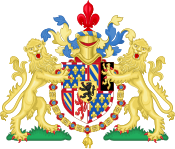| House of Valois-Burgundy | |
|---|---|
 | |
| Parent house | House of Valois |
| Country | |
| Founded | 6 September 1363 (1363-09-06) |
| Founder | Philip the Bold |
| Final ruler | Mary of Burgundy |
| Titles |
List
|
| Estate(s) | Palace of the Dukes |
| Dissolution | 23 March 1500 (1500-03-23) |
The House of Valois-Burgundy (French: Maison de Valois-Bourgogne, Dutch: Huis van Valois-Bourgondië), or the Younger House of Burgundy, was a noble French family deriving from the royal House of Valois. (It is distinct from the Capetian House of Burgundy, descendants of King Robert II of France, though both houses stem from the Capetian dynasty.) The Valois-Burgundy family ruled the Duchy of Burgundy from 1363 to 1482 and eventually came to rule vast lands including Artois, Flanders, Luxembourg, Hainault, the county palatine of Burgundy (Franche-Comté), and other lands through marriage, forming what is now known as the Burgundian State.
The term "Valois Dukes of Burgundy" is employed to refer to the dynasty which began after King John II of France granted the French Duchy of Burgundy to his youngest son, Philip the Bold in 1363.
During the Hundred Years' War of 1337–1453, the dukes rivalled their French royal cousins, uniting a great number of French and Imperial fiefs under their rule. However, their plans to establish an autonomous kingdom ultimately failed when the last duke, Charles the Bold, sparked the Burgundian Wars of 1474 to 1477 and was killed in the Battle of Nancy in January 1477. The final ruler of the dynasty was his daughter, Mary (r. 1477–1482). On her death in 1482 her lands outside of France passed to her eldest son, Philip the Handsome, to become the Habsburg Netherlands; in the course of the War of the Burgundian Succession (1477-1482) the King of France had claimed the Duchy of Burgundy itself by escheat. Mary's death marked the end of the House of Valois-Burgundy.
History
See also: List of territories of the Valois dukes of BurgundyThe former Frankish Kingdom of Burgundy had been divided into an East and West Frankish part by the 843 Treaty of Verdun. While the eastern part evolved to the Kingdom of Burgundy-Arles that included the Free County of Burgundy and was incorporated into the Holy Roman Empire in 1032, the western Duchy of Burgundy, established about 918 by Richard the Justiciar, became a fief of the French royal House of Capet under King Robert II in 1002. To meet the demands of the Burgundian nobles for autonomy, King Robert installed his second son Henry as Duke of Burgundy about 1016, a title that passed to his younger brother Robert I and his descendants after Henry had succeeded his father as King of France in 1031.
The Capetian House of Burgundy became extinct when Duke Philip I died in 1361, before he was able to consummate the marriage with Margaret of Dampierre, heiress of Count Louis II of Flanders. The Duchy of Burgundy was then unified with the French royal domain under the Valois king John II. Soon after, however, John's fourth son Philip the Bold received the Duchy of Burgundy as an appanage from the hands of his father.

Philip the Bold ruled as Duke Philip II of Burgundy from 1363 to 1404. In 1369 he himself married the widowed Margaret of Dampierre, and when his father-in-law Count Louis II of Flanders died in 1384, he succeeded him not only in the French counties of Flanders, Artois, Rethel, and Nevers, but also in the Free County of Burgundy, becoming a direct vassal of the Holy Roman Emperor. The next year he arranged the double wedding of his son and heir John the Fearless with Margaret of Wittelsbach, daughter of Duke Albert of Bavaria-Straubing and sister of Prince William II of Bavaria, who himself married Philip's daughter Margaret. Already upon the death of King Charles V of France in 1380, Philip together with Duke Louis I of Anjou and Duke John of Berry had acted as regent for his minor son King Charles VI. As Charles VI suffered from increasing mental derangement, Philip tried to spread his influence across the French kingdom, which met with the fierce resistance by the king's younger brother Duke Louis I of Orléans.
Raised in Flanders, Duke John the Fearless succeeded his father in 1404 and unified the heritage of his mother Margaret of Dampierre with the Burgundian duchy. Ceding the French counties of Nevers and Rethel to his younger brothers Philip II and Anthony, he began a skilful see-saw policy to create a scope for free action while the French lands were ravaged by the Hundred Years' War against the Kingdom of England. Like his father he quarrelled with his Valois cousin Louis I of Orléans, whom he had assassinated in 1407. The remaining tensions with the Orléans liensmen led to the French Armagnac–Burgundian Civil War, whereby Duke John allied with King Henry V of England and in 1418 occupied Paris, but was lured into an ambush and murdered by the Armagnac leader Tanneguy du Chastel the next year.

John's son Philip the Good, Duke of Burgundy from 1419, renewed his father's alliance with King Henry V of England when he signed the Treaty of Troyes in 1420 against the French Dauphin Charles VII. He first concentrated on enlarging the Burgundian territories, acquiring the succession in the Imperial County of Namur in 1421 (with effect from 1429) and succeeding his cousin Duke Philip of Saint-Pol in the Imperial duchies of Brabant and Limburg. He also secured the Bavaria-Straubing heritage of his mother Margaret of Wittelsbach and his uncle Duke John III of Bavaria-Straubing, when finally in 1433 the last Straubing heiress Jacqueline ceded the Imperial counties of County of Hainaut (Hennegau), Zeeland, and Holland, as well as Frisia to him. By the 1435 Congress of Arras Duke Philip acknowledged the rule of King Charles VII of France and in turn reached the formal independence of the Burgundian lands from the French Crown. In 1441 he also purchased the Duchy of Luxembourg from the last duchess regnant Elisabeth of Görlitz.
The Valois-Burgundy duke Charles the Bold, ideal picture of a knightly duke, wore himself out in armed conflicts. With the acquisition of Guelders, the Burgundian Netherlands reached their greatest extent. Charles' plans to accomplish the rise of his dynasty peaked in the negotiations with the Habsburg emperor Frederick III about his elevation to a "King of Burgundy" and the marriage of his daughter Mary to Frederick's son Archduke Maximilian of Austria. Enraged at the reluctance of the emperor, Charles started the unsuccessful Siege of Neuss in 1474 and became involved in the Burgundian Wars against the Duchy of Lorraine and the Swiss Confederacy. In consequence, Mary acceded the Burgundian crown when Charles was killed in the 1477 Battle of Nancy.
The Burgundian heritage eventually passed to the Habsburg archduke Maximilian, who married Mary of Burgundy seven months after her father's death and could ward off the claims raised by King Louis XI of France in the 1479 Battle of Guinegate. The French king could only seize the Duchy of Burgundy proper, Artois, and the former Burgundian fiefs in Picardy. The House of Habsburg abruptly rose to a royal dynasty of European scale, however, at the price of the centuries-long France–Habsburg rivalry.
Dukes of Burgundy (1363–1482)
| Dukes of Burgundy | |||
|---|---|---|---|
| House of Valois-Burgundy | |||
| Image | Name | Date | Notes |
 |
Philip the Bold | 1363–1404 | Fourth son of King John II of France from the House of Valois and his wife Bonne of Luxembourg. Married Countess Margaret III of Flanders in 1369. |
 |
John the Fearless | 1404–1419 | First-born son of Philip the Bold. United the heritage of his mother with Burgundy. Married Margaret of Bavaria in 1385. |
 |
Philip the Good | 1419–1467 | First-born son of John the Fearless. Acquired most of the Burgundian Netherlands. |
 |
Charles the Bold | 1467–1477 | Only legitimate heir of Philip the Good and his third wife Isabella of Portugal. Last Valois duke of Burgundy, killed in the Battle of Nancy. |
 |
Mary | 1477–1482 | Only child of Charles the Bold and his second wife Isabella of Bourbon, married the Habsburg archduke Maximilian I of Austria in 1477. |
Coats of Arms
See: Coats of Arms of the 2nd House of Burgundy
Category:Coats of arms of the Duchy of Burgundy
-
 Philippe the Bold, as count of Touraine
Philippe the Bold, as count of Touraine
-
 Philippe the Bold, as duke of Burgundy
Philippe the Bold, as duke of Burgundy
-
 Jean the Fearless, duke of Burgundy
Jean the Fearless, duke of Burgundy
-
 Philippe the Good and Charles the Bold, as dukes of Burgundy
Philippe the Good and Charles the Bold, as dukes of Burgundy
-
 Charles the Bold, as count of Charolais
Charles the Bold, as count of Charolais
-
 Corneille and Antoine the Grand Bastard
Corneille and Antoine the Grand Bastard
See also
- History of Burgundy
- Burgundian State
- Genealogy of the 2nd House of Burgundy
- Genealogy of Dukes of Burgundy
- Passport to Pimlico
References
- Boltanski, Ariane (2006). es ducs de Nevers et l'État royal: genèse d'un compromis (ca 1550 - ca 1600). Librairie Droz S.A. p. 501.
- Although, the Burgundian state passed to Mary the Rich, the last male representative of the House of Valois-Burgundy was actually a grandson of Philip the Bold, John II, Count of Nevers (20 October 1415 – 25 September 1491), and the last legitimate male-line descendant of the house was his second daughter, Charlotte, Countess of Rethel (c. 1472 – 23 August 1500), wife of Jean d'Albret, Sire of Orval, and mother of Marie d'Albret, Countess of Rethel (see Boltanski 2006).



